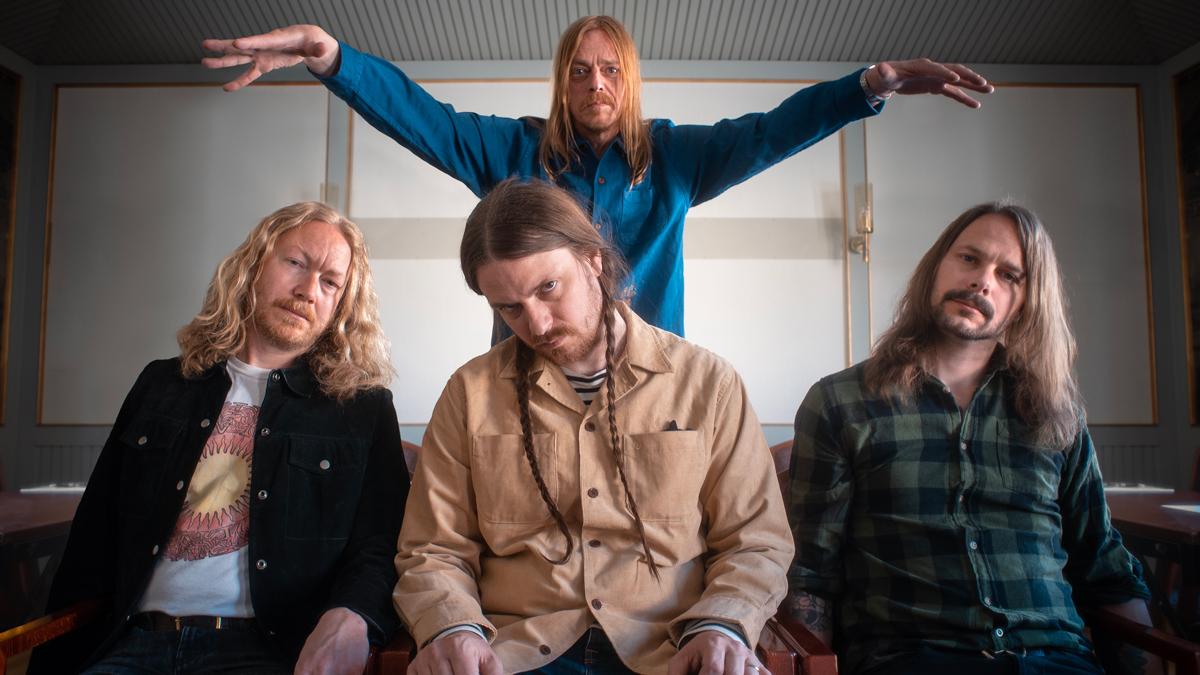“A humbucker is a lot more controlled, and a single coil is twangy and misses frequencies. The P-90s have the best of the two worlds”: Meet Graveyard, the Swedish classic rockers with tone and vibrato worthy of the ‘60s psychedelic blues explosion
Inspired by the likes of Peter Green, Danny Kirwan and Jimi Hendrix, Joakim Nilsson and Jonatan Ramm thrive on P-90 pickups, cranked Marshall Bluesbreakers and world-class vibrato – just don’t call their high-octane rock ’n’ roll “retro”

Formed back in 2006 in Gothenburg, Sweden, Graveyard have long since mastered the art of gutsy blues-infused rock ’n’ roll. After returning to the studio for the first time since the pandemic, their sixth LP – which is succinctly titled 6 – sees them paring back the B.R.E. (Big Riff Energy) for an altogether more subdued and soulful trip.
Deeply influenced by the architects of the late ‘60s and early ‘70s psychedelic blues explosion – players like Peter Green, Danny Kirwan and Jimi Hendrix – resident six-stringers Joakim Nilsson and Jonatan Ramm describe having set out to make it their “most guitar-based” album yet.
With classic amp tones, classic guitars and homemade “rip-offs” of classic pedals at the core of 6’s sonic makeup, it’s about as authentically classic-sounding as you could wish for an album to be in today’s increasingly digitized world – just be careful how else you describe what these Swedish stalwarts are all about.
“It’s what we do: it’s rock done in a classic way,” says Joakim matter-of-factly. “I have no problem with the classic rock term. For me, it’s worse if you call it “retro” or something like that.”
Like a dirty word that implies slipping into a kind of rock ’n’ roll cosplay whenever the aesthetic cycles into vogue again, many bands have dabbled, only to change their look and sound with the next passing trend. But Graveyard have been doing what they do for 17 years because it is who they are – trendiness be damned.
“It’s never been popular [in Sweden],” laughs Joakim. “Maybe there was a time in the early ’90s when guitar music was popular, and maybe in the beginning of the ’70s, but other than that, it’s never been the mainstream kind of music. The metal scene is big, but you still wouldn’t call it mainstream, even though it sells more albums than other kinds of guitar music.”
So, why choose now to go for broke in the guitar stakes?
Get The Pick Newsletter
All the latest guitar news, interviews, lessons, reviews, deals and more, direct to your inbox!
“It felt like it was pretty natural,” suggests lead guitarist Jonatan, whose distinctive soloing style and absolutely furious vibrato technique get far more bars in the spotlight than they did on 2018’s Peace. “It’s always hard to follow a plan, you know? It just turns out the way it does in the end.”
But, according to Joakim, the real difference was that the two guitarists were left in charge of songwriting duties this time around instead of bassist/backing vocalist, Truls Mörck, who wrote the majority of Peace. “This time, he kind of wanted us – and let us – write many of the songs. He kind of made us,” says Joakim.
Where Peace was powered by a thunderous rhythm section with pummeling grooves, 6 puts more of its emphasis on kaleidoscopic explorations of melody and the individual sonic thumbprints of Joakim and Jonatan.
I do remember having to choose between either a slow vibrato or a fast one… and I ended up with a fast one!
Jonatan Ramm
“Joakim has that tone that’s a little bit more bluesy and jazzy than anyone I’ve ever heard,” effuses Jonatan, before Joakim returns the compliment in kind, suggesting that Jonatan’s tone is simply like “nobody else”.
Sure enough, the lead man’s trademark vibrato is difficult to compare with any of the most commonly emulated string wobblers in rock and blues. It has the speed of B.B. King, the expression of Peter Green, the wild abandon of Rory Gallagher or Jimmy Page and the sheer muscularity of Tony Iommi or Angus Young, and yet it sounds like none of them.
“That’s my thing,” he shrugs. “It’s been around for a while, but I do remember having to choose between either a slow vibrato or a fast one… and I ended up with a fast one! Mostly, I keep to that.”
He employs an almost exaggerated up-and-down motion using his full forearm to load up the strings with kinetic energy, rather than the more commonly used ‘anchor and pivot’ vibrato technique, which uses just the hand.

His main guitar of choice – a Gibson SG Special from 1970 – was fitted with a Vibrola arm and tailpiece when he first acquired it, but he had them removed and replaced with a standard wraparound bridge to eradicate some pesky issues with tuning stability. His in-built knack for string trembling more than makes up for the loss of this particular piece of hardware.
For the album, Joakim solely used Gibson ES-330 hollowbody electric guitars. “Usually I use something weird – something different-sounding – like an old Hagstrom or a Jazzmaster or something like that, but not this time around,” he tells us.
Both guitarists favor P-90 pickups for the simple reason that they’re “a world in between the humbucker and the regular single coil.”
“I don’t know the technical stuff about it,” says Joakim. “But, for me, a humbucker seems a lot more compact-sounding or controlled, and a single coil is sometimes lacking tone. It’s twangy and it misses a lot of frequencies. For me, the P-90s have the best things from the two worlds.”
Amp-wise, Marshall Bluesbreakers are the order of the day, and there’s a modern Reissue as well as a 1974 model in the Graveyard camp. Joakim also used a Peavey Classic 20 to cut the record.
Beyond some standard wah, delay and reverb pedals, there are interesting things afoot in the effects department.
“It feels like I just got into pedals,” says Joakim. “I didn’t use them for a long time – just a tuner – but for a while I’ve had an interest in building pedals, or really mostly ripping off classic pedals. So, that’s what I’m using now.” He has homemade “rip-offs” of a Pro Co RAT, the MXR Micro Amp and a fuzz pedal based on the Electro-Harmonix Big Muff.
He does it, he says, not to improve on these classic designs as such, but because he can. “It’s not magic, it’s just electronics!” he insists.
I’ve never really practiced… I would have stopped a long time ago if I just sat playing scales
Joakim Nilsson
“I’ve worked with electronics my whole life so it’s not that hard for me – you know, soldering and stuff. It’s just sourcing the schematics online and sourcing the components. If you want the correct version of those pedals that you ‘should’ have, with the good-sounding stuff in, it’s a lot more expensive than just making it, and I thought it was kind of fun, too!”
Beyond investing in a soldering iron and a DIY mentality, we asked Joakim and Jonatan if they had any further advice for aspiring guitarists to get the most out of their playing and – just like dabbling with electronic components – it’s all about the ‘F-word’:
“I’ve never really practiced,” says Joakim. “Just playing is fun and I would have stopped a long time ago if I just sat playing scales.”
“It should be something free,” adds Jonatan. “It should make you feel free at least.”
- 6 is out now via Nuclear Blast Records.
Since graduating university with a degree in English, Ellie has spent the last decade working in a variety of media, marketing and live events roles. As well as being a regular contributor to GuitarWorld.com, she currently heads up the marketing team of a mid-scale venue in the south-west of England. She started dabbling with guitars around the age of seven and has been borderline obsessed ever since. She has a particular fascination with alternate tunings, is forever hunting for the perfect slide for the smaller-handed guitarist, and derives a sadistic pleasure from bothering her drummer mates with a preference for wonky time signatures.
“Classic aesthetics with cutting-edge technology”: Are Seymour Duncan's new Jazzmaster Silencers the ultimate Jazzmaster pickups?
“We’re all looking for new inspiration. Some of us have been playing humbuckers for a long, long time”: Are we witnessing a P-90 renaissance? Warren Haynes has his say












